Barley powdery Mildew
Barley powdery Mildew
Published: 1 Mar 2012
The two most important strategies for powdery mildew
The two most important strategies in preventing and controlling barley powdery mildew are:
- selecting varieties with improved resistance; and
- timely applications of effective fungicides.
Key points
- A single gene mutation in populations of the powdery mildew pathogen has caused disease control failure by some triazole fungicides.
- Use integrated disease management to reduce disease pressure and reliance on fungicides.
- Avoid VS and S varieties whenever possible in disease-prone areas.
- Use an effective seed dressing for early crop protection.
- Apply effective fungicides as soon as the disease becomes apparent; early control is essential to maximise fungicide efficacy.
- Strobilurin-based products (Group 11) should be used as preventive control rather than curative control; rotate with effective new generation DMI - based products (Group 3).
- Do not use tebuconazole fungicide to control barley powdery mildew; it is no longer effective in Western Australia.
Powdery mildew is a major issue for growers in the western region, particularly in south-west Western Australia. The selection of susceptible varieties and
emergence of fungicide resistance makes it a difficult disease to manage.
The declining efficacy of some triazole-based fungicide products is the result of mutations in the barley powdery mildew pathogen.
Losses to barley powdery mildew have previously been estimated at $30 million annually in WA. The epidemics of the disease in 2010 and 2011 resulted in substantial yield losses. Together with downgrading of malt barley to feed, the economic cost of the outbreaks could total more than $200/ha.
Download PDF
Region: West
GRDC Project Code: CUR1106-001RTX,

